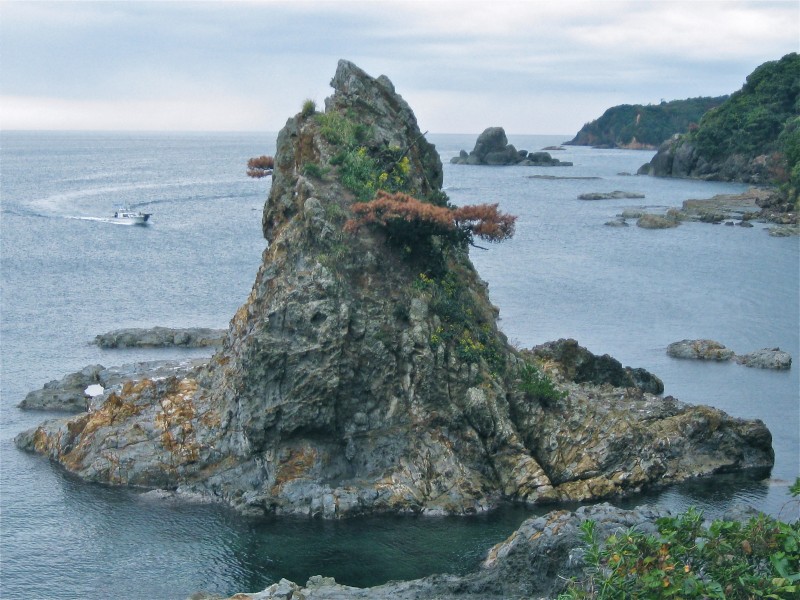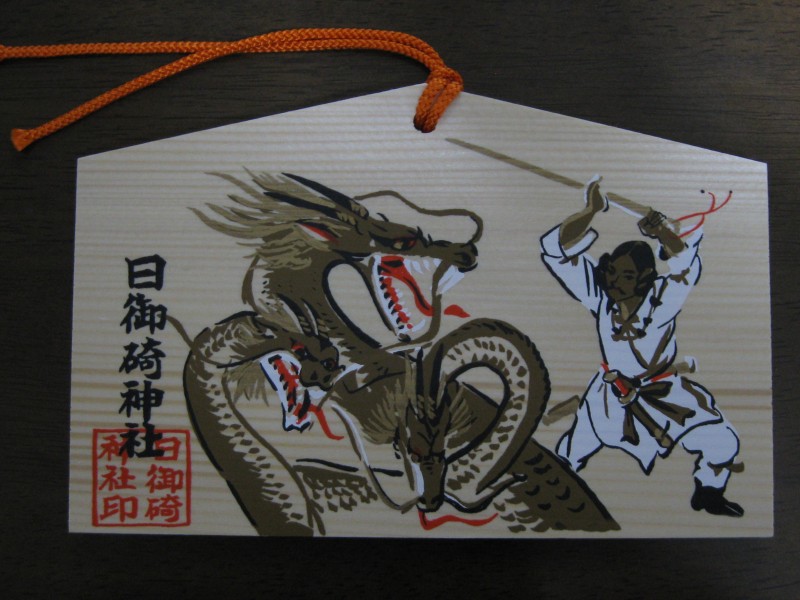It’s kamiari time in Izumo, when all the gods of Japan (except Ebisu) gather for their annual meeting in Shimane. How appropriate then that Green Shinto should carry a piece about Shimane.
2012 marked 1300 years since the publication of Kojiki. To mark the occasion Shimane Prefecture commissioned an English language website, which Izumi Hasegawa of the Shusse Inari Jinja in Matsue worked on. Our thanks to her for drawing our attention to this gem of a website.
As readers of Green Shinto will know, we are a big fan of the attractive Izumo Province, which is full of folklore, historical sites and mythical associations. These have previously been hard to access for English speakers, but now light is shed thanks to Izumi’s work on the website.

Shimane coast, along the coast to Hinomisaki
The contents include a piece about the Kojiki; the entry to the underworld (Yamotsu Hirasaka); the fearsome monster, Yamata no Orochi; Tales of Okuninushi; the splitting of the country, known as Kunibiki; the role of Saké; the roots of Kabuki (Izumo no Okuni); Izumo Taisha, grandest of all shrines; and a feature article on Sengu rebuilding.
Our favourite piece is the account of Okuninushi and the Rabbit (or Hare), because of the compassion it shows with animals. Sadly, despite being an animist religion, Shinto’s record on animal rights is not noteworthy. The historical ban on eating meat was instigated on Buddhist principles, and there is no known case in which Shinto priests have spoken out against animal cruelty. Here in the tale of Okuninushi are grounds for thinking they should.
*******************
The following is taken with acknowledgement from http://www.japanesemythology.jp/okuninushi/
Okuninushi and the Rabbit
Okuninushi lived in the land of Izumo in Ashihara-no-nakatsukuni with his numerous brothers. One day, his brothers heard of a goddess of unrivaled beauty named Yagami-hime. She lived in the land of Inaba, and every one of them wanted to ask for her hand in marriage. When they set out for Inaba, they brought Okuninushi along as their servant to carry their baggage, which was so heavy that he soon lagged behind the group.

Cape Keta, where Okuninushi met the rabbit of Inaba. (photo from website)
When his brothers reached Cape Keta in Inaba, they came upon a rabbit lying on the ground that had been stripped of its skin and was crying in pain. The brothers said to the rabbit, “You should wash off in seawater and then climb to the top of a high hill where the winds blow strongly to dry off. You’ll recover very quickly if you do.”
So the rabbit did as it was told, but instead of recovering, things got worse. As the winds blew, its skin dried and cracked, and the salt from the seawater got into its cracked skin. It couldn’t stand the pain, and fell down crying.
When Okuninushi, who was still trailing the group, finally reached Cape Keta, he saw the rabbit crying out in pain, and asked it what had happened.
The rabbit replied, “I’m from the island of Oki, and I wanted to cross over to the mainland. There was no way for me to do it on my own, so I decided to fool the sharks that live in the waters around Oki. I called out to one of the sharks, ‘Let’s see which there are more of, you sharks or us rabbits. Have all your fellow sharks line up one by one from here to Cape Keta, and I’ll count you. Then we’ll know for sure which group is bigger.’ ”
“And they did just like I said. So I ran over them, counting each one, and just as I was about to reach land, I said, ‘I just tricked you all into doing what I wanted.’ Just then, the last shark in the line caught me and bit my fur right off me. As I was lying here, a large group of gods came along and told me to wash off in seawater and then go where the wind would dry me off. I did what they told me, but now things are even worse.”

This bronze statue of Okuninushi and the rabbit of Inaba is on the grounds of Izumo Taisha. (photo from website)
Hearing this, Okuninushi told the rabbit, “Go to that river over there and wash off in fresh water. Then gather some cattails, spread them out on the ground and roll over them. You’ll be as good as new in no time.” So the rabbit did as it was told, and soon it had completely healed.
Then the rabbit said to Okuninushi, “Your brothers will never earn the love of Yagami-hime. Even though you look like a poor servant, she will fall in love with and marry you.” When Okuninushi finally arrived at Yagami-hime’s palace, the rabbit’s prediction came true. Yagami-hime said to his brothers, “I will have nothing to do with any of you. Okuninushi is the one I will marry.”Hearing this, his brothers were enraged, and they decided to kill Okuninushi. Each time they tried, his mother came to his rescue and was able to save him, but their plots became so frequent that his mother said to him, “If you stay here, your brothers will succeed in killing you.” So Okuninushi fled far away, to the house of Susano-o in the land of Ne, the Underworld.
******************
For the Shimane website on mythology, click here.
For Matsue and its connections with Lafcadio Hearn, click here.
For a review of a PhD on Izumo Taisha, click here.
For a piece on Izumo no Okuni, founder of kabuki, click here.
All about the mists, myths and otherness of Izumo here.
The wonderful Izumo Taisha is written about here.

Susanoo slays the monster Orochi, just one of the many myths set in the Izumo region

Leave a Reply